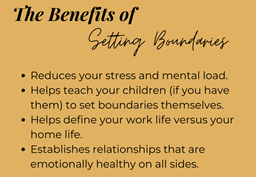Setting and sustaining boundaries is a crucial skill. Whether it’s work or personal relationships, poor boundaries may leave us feeling depleted, resentful, hurt, angry, burnt out, taken advantage of, taken for granted, or intruded upon.
Michelle Morgan, co-founder of Livity sums up the importance of boundaries well, “For me, setting boundaries is an essential, non-negotiable part of looking after my mental health and wellbeing … Introducing new boundaries into your life will undoubtedly require you to have some conversations that feel awkward, just know that it’s almost always worth holding that uncomfortable moment and pushing on through to have the conversation, rather than avoiding it.”

Here are eight ideas to consider when making boundaries part of your everyday work routine.
- Assess your personal boundaries first. These stem from your values and your life priorities – keeping in mind that aside from work, you have your home life, your relationships, your passions, and your personal space to consider.
- Communicate Upfront. Once you have your values and priorities in place, communicate them. Communication is the safeguard against potential misunderstandings.
- Create clear structures. Be the architect of your boundaries. Set up “do-not-disturb” work blocks of time. Create clear guidelines of responsibility and accountability of tasks.
- Keep your relationships professional. This does not mean you shouldn’t have an at-work confidante or close friend, however, by and large, keep your work relationships professional.
- Delegate work when appropriate. It is important to set expectations about the work you will do, that you were hired to do, the work you are willing to pick up, and work that is clearly outside of your responsibility. And yes, you can still delegate work, even when you’re not a manager.
- Say no. Saying no is a lot easier said than done, especially in the workplace. Sometimes it takes some finesse and dialogue. Take time to explain your work scope and responsibility in light of a new request asked by someone on your team – whether that’s a leader, supervisor, or colleague.
- Take time off. Use the time you’ve earned and are given. Set an out-of-office message and take the time to disconnect, rest and recharge.
- Use technology to help. Keep your calendar up to date to show when you are and are not available. Use away-messages on platforms, and your email out-of-office when you are taking time off to redirect incoming emails to the right resource.
Lastly, prepare for push-back and boundary-breakers, and use it as an opportunity to grow this skill and instruct others on how to best communicate with you, when it is appropriate to disrupt you, and what they can realistically expect from you.
Sources:
https://www.vogue.com/article/practical-ways-to-set-boundaries-and-stick-to-them-in-2022
https://www.careercontessa.com/advice/healthy-boundaries-at-work/
